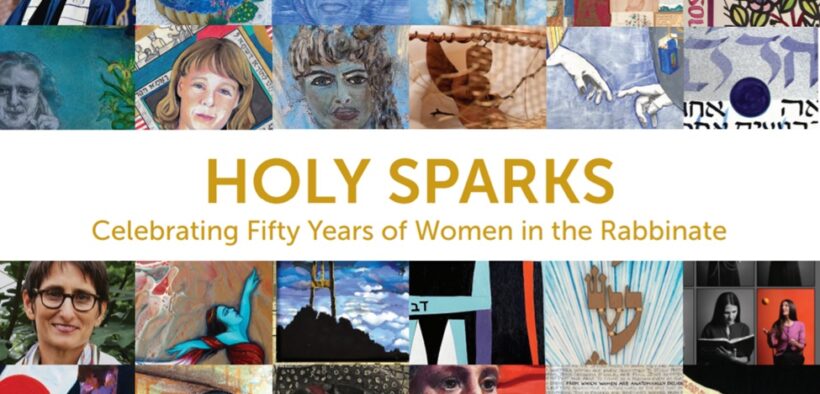SoCal rabbis featured in ‘Holy Sparks’ art exhibit celebrating 50 years of Jewish female pioneers

Sally Priesand made history when she was ordained by Hebrew Union College Jewish Institute of Religion (HUC-JIR) on June 3, 1972, as the first female rabbi in North America. Priesand represented the first step toward inclusion, diversity, equity and empowerment of a new contingent of Jewish leaders all over the world.In the runup to the 50th anniversary of that event, “Holy Sparks,” a new art exhibition produced by The Braid‘s Story Archive of Women Rabbis and preserved at the Jewish Women’s Archive, celebrates five decades of the commitment and vision of 24 pioneering women. The exhibition is collaboration of HUC-JIR and The Braid.
Two dozen leading contemporary Jewish female artists who immersed themselves in their respective rabbi’s recorded interviews, evoke the struggles and success of 24 women who were trailblazers in their time. Among them are local Temple Emanuel of Beverly Hills Rabbi Emeritus Laura Geller, Nashuva Rabbi Naomi Levy and IKAR Senior Rabbi Sharon Brous. Together, they represent the achievements of 839 female rabbinical graduates of HUC-JIR in North America and Israel to date, and nearly 1,500 female rabbis from an array of movements who have transformed Jewish tradition, scholarship, education and pastoral care.
“Since 2009, Lynne Himelstein and I and our team at The Braid have had the honor of interviewing nearly 200 trailblazing women rabbis from all denominations and across the globe, offering a front-row seat into one of the most transformational moments in Jewish history,” said Ronda Spinak, founder and artistic director of The Braid and co-director of The Braid’s Story Archive of Women Rabbis. “Having already dramatized these stories in our landmark play ‘Stories from the Fringe,’ we wanted to bring these inspiring legacies to a new medium: the visual arts. So, we approached HUC-JIR with the exciting idea of an art exhibition celebrating 50 years of women in the rabbinate.”
Himelstein added, “Each rabbi has such a unique voice and is deserving as a ‘first’ in her own right, so it was challenging to winnow it down to just 24 of these incredible pioneers. Just as much thought had to go into pairing a rabbi with an artist.
The works in the exhibition include representational and conceptual portraits of the rabbis in a variety of mediums: photography, textile, painting, mixed media, collage, drawing and recycled materials, each informed by the rabbi’s life and mission.
The online “Holy Sparks” exhibition catalogue features images, artists’ statements, and rabbis’ biographies.
- A tribute to the legacy of Regina Jonas as the first female rabbi in modern times, ordained in Berlin in 1935 and died at Auschwitz in 1944
- 1972: Rabbi Sally Priesand illuminated by the rainbows that have brought blessing to her life in Joan Roth’s dazzling digital photograph
- 1974: Rabbi Sandy Eisenberg Sasso’s revelation of the spiritual imagination portrayed in Debra Band’s paper cut depicting the Torah as a clay jar emitting jewels
- 1975: Rabbi Laura Geller’s leadership and inspirational friendship conveyed in Ruth Weisberg’s tender portrait
- 1975: Rabbi Jackie Tabick’s parable about inadvertent good deeds as the hands of God evoked in Sandy Bliefer’s three-dimensional work
- 1981: Rabbi Kinner Shiryon’s traversing the fault lines of serving as a community rabbi in Israel depicted in a dissonant collage by Heddy Breur Abramowitz
- 1982: Rabbi Amy Perlin’s community building expressed in Deborah Ugoretz’s paper cut portraying her with Torah aloft amidst the values-driven blossoming congregation she founded
- 1985: Rabbi Amy Eilberg surrounded by images of her social justice and human rights work by Pat Berger
- 1986: Rabbi Julie Schwartz’s military chaplaincy captured by Emily Bowen Cohen’s comics-informed panel
- 1988: Rabbi Denise Eger’s compassion for HIV/AIDS patients in the 1980s evoked by Dorit Jordan Dotan’s angelic imagery
- 1989: Rabbi Naomi Levy’s gathering of souls conveyed by Judy Sirota Rosenthal’s mixed media and music installation
- 1990: Rabbi Pauline Bebe’s congregation’s ethos depicted by Tamar Hirschl’s amalgamation of Parisian and Jewish imagery
- 1992: Rabbi Naamah Kelman’s struggles for pluralism and women’s empowerment in Israel expressed by Ellen Alt’s calligraphic work
- 1993: Rabbi Andrea Weiss’ scholarship and biblical mantra of
- ‘words flowing as dew” conveyed by Debbie Teicholz Guedalia’s photo collage
- 1995: Rabbi Diane Cohler-Esses transcending boundaries as a Jew of color depicted by Siona Benjamin’s soaring blue figure reflecting the infinite sky and sea
- 1998: Rabbi Noa Kushner’s holding of names of those loved and lost in her “kitchen” community expressed by Harriete Estel Berman’s Hanukkah menorah of recycled materials
- 1998: Rabbi Hara Person’s journey built on words depicted in Elizabeth Langer’s scripture-laden patchwork collage
- 2001: Rabbi Angela Warnick Buchdahl’s Korean and Jewish heritage-infused prayer and song evoked by Lauria Gross
- 2001: Rabbi Sharon Brous’ impassioned persona captured in Penny Wolin’s multi-image photographic portrait
- 2002: Rabbi Claudia Kreiman’s crisis of faith towards humanity expressed in Marisa Takal’s psychic landscape
- 2003: Rabbi Gesa Ederberg’s revitalization of Judaism in Berlin portrayed by Yona Verwer’s abstract imagery evoking German Jewry’s past splendor
- 2007: Rabbi Tanya Segal’s Jewish renaissance in Poland captured by Linda Soberman’s portrait embedded in Krakow’s past
- 2009: Rabba Sara Hurwitz’s community-driven leadership conveyed by Kathryn Jacobi’s painting of her world shaped by her family and students
- 2012: Rabbi Rachel Adler’s landmark feminist essay recorded as a page of Talmud by Marilee Tolwin’s drawing
- 2013: Rabbi Tamara Cohn Eskenazi’s faith after the Holocaust conveyed by Carol Hamoy’s commandment-inscribed gloves
The exhibition will be presented at the Dr. Bernard Heller Museum in New York by the Irma L. and Abram S. Croll Center for Jewish Learning and Culture from Feb 1- May 8, and at the Skirball Museum in Cincinnati with the support of the Cincinnati Skirball Museum Activities Fund from May 19- Sept. 4